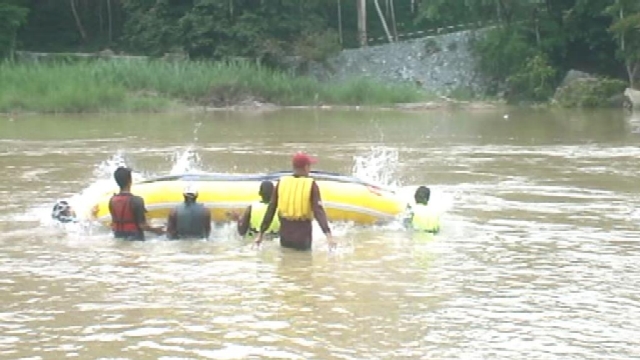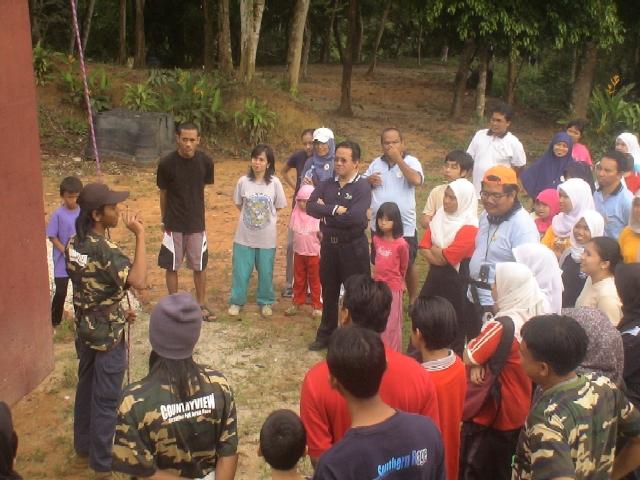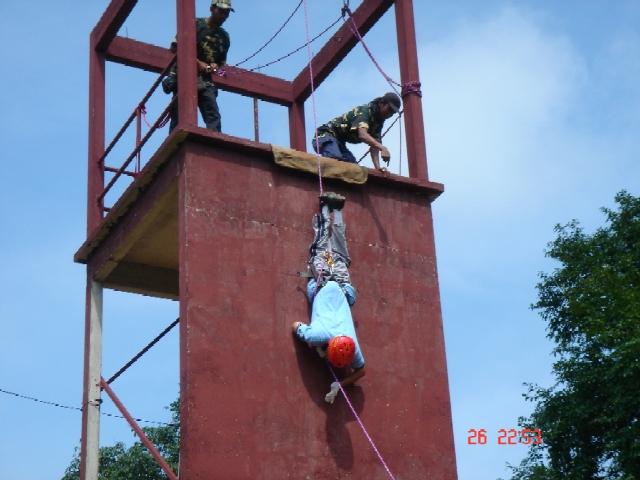Last weekend I joined members of UKM Medical Molecular Biology Institute (UMBI) for a retreat at Jeram Besu Countryview Recreation Park & Resort (N4o 00.920, E101o 56.286). Beside mapping out the future course of the institute, the retreat was meant to foster camaraderie between members of the institute and to strengthen the mental toughness of each individual. Since the resort is a nice hideaway amidst the rainforest of Pahang, it allows the members of the institute to be alone with themselves.
Day 1
I joined the support staff for the bus ride from HUKM Cheras on Friday morning at 8.30 am, since my Fiat Ulysse was in the workshop for repairs. We reached the place at noon, in time for lunch and Friday prayers at a nearby mosque.

I had 2 electronic compass on me (Casio CPW-310 watch and Garmin eTrex Vista C), so I checked the qiblat of the mosque. The qiblat of the mosque was correct at 292 degrees.

PrayMind indicating the qiblat for Jeram Besu
Therefore I was very surprised when at prayer time, the locals and the imam prayed at the angle of 330 degrees. After prayers, I tried to inform the locals of the discrepancy. But I don’t think anybody paid me any heed. Apparently they believed in their young imam and the mosque committee. I did my best, now it is in the hands of Jabatan Agama Islam Pahang (JAIP) to follow up on this matter.
The discrepancy also occurs for the qiblat in the rooms at the resort. Instead of Mecca, their qiblat is Dhaka.
Upon reaching the resort, we got ready for our first activity, white-water boating.
White-water Boating
White-water is moving water whose surface becomes turbulent or frothy either by passing over rocks, through a narrow river channel, or down a steeper gradient. It is also known as rapids (or “jeram” in Malay) or wildwater. Therefore white-water boating is a wild, thrilling ride downriver, using only your paddles to keep your boat afloat, keeping it from tipping over.
Initially only the support staff (18 of them) were supposed to do the white-water boating. The Fellows and their families were supposed to go to a waterfall for a picnic. Since only 3 Fellows have arrived by 2.30pm, there were not enough people for the waterfall trip. So the three of us Fellows (plus 2 kids) had to join the white-water boating trip.
Before we can go on the white-water boating, all of us have to pass the water competence test first. The test consists of 3 parts;
- learning to float using a life-vest
- learning to float on fast-flowing rapids
- learning to float once the boat has turned over.
Part one of the water competence test.
Some of us just couldn’t let go 😀
Waiting to jump into the rapids.
Diving into the rapids as part 2 of the water-competence test.
Water-competence test part 3, being thrown overboard from the boat.
Participants being brought to the middle of the river inside the boat.
The boat being turned over.
Splash! I got kicked in the head once. Luckily I was wearing a helmet.
After all of us has passed the water-competence tests, we were divided into 3 groups, each group to one boat for the long ride downriver.

The boat ride was 3.9 km long and lasted for 45 minutes. There were enough rapids along the way to keep the 23 participants on their toes. It was a grade 2 rapids (1 is the easiest and 5 is the toughest). There was one stretch where there was a fast one metre drop, which was quite a thrill since the risk of tipping over was quite high (balls shrinking moment ;-)).
Upon reaching Benta town, we lifted the boats from the river and loaded them onto the vehicles. We got onto 3 vans for the final part of the ride. The boats and the participants were dropped half a kilometer upriver to where we initially started.
We were placed 4 to a boat and we rowed to try out the grade 4 rapids. Out of the 5 rides, 3 boats spilled over, including my boat, throwing the participants into the water. The most memorable moment was when one of the participants from my boat kept shouting out for me to rescue him, non-stop, till I managed to stop him from floating away. That night (and the following days!) he was mercilessly kidded about it. “Dr Azmiiiiiiiiiiii, tolong sayaaaaaaaaaaaaaaaaaaaaaaaaa, tolong sayaaaaaaaaaaaaaaa!” became the most popular taunt of the retreat 🙂
I’m just glad that I made it through alive. Thinking about the final stretch, I still get palpitations.
Things that I would do differently in the future;
- Wear bicyling shorts instead of track bottom, so that I can use my legs for swimming if thrown overboard. (I was already wearing bicycle shorts underneath my track bottom, but I didn’t take the track bottom off for the sake of decency.)
- Wear well-fitting shoes or diving booties. But I should take off the shoes for the final stretch at the grade 4 rapids so that I can use my legs for swimming. We still need the shoes at Benta since the residents of Benta uses the riverside to dump dangerous objects such as broken glass.
- I used an elastic sports holder to anchor my spectacles. I should’ve worn my swimming goggles instead of my glasses for the final stretch.
- Leave my GPSr behind for the final stretch. I nearly lost it when i was thrown out of the boat.
Why? Because swimming in a river with fast flowing current is not like swimming in a swimming pool. Once you start trying to swim against the current, you get tired very easily, especially with your track bottom and your shoes pulling you down.
That night we had our discussion in matters relating to the institute. I had a very good night sleep since I was very-very tired.
Day2
Abseiling
Abseiling is a technique for descending vertical cliff faces using harnesses, ropes and safety equipment. It came from the German word abseilen, which means “to rope down”. That was the activity for day 2.
Initially we were briefed on abseiling technique and its equipment and on how safe it is. Then we had a demonstration by the demonstrator.
Then almost everybody, including the director of the institute, abseilled down the vertical wall, which was about 3 stories high. I went down very fast indeed since my right hand couldn’t get a good grip on the rope. We were given only cotton gloves to wear. I suffered rope burns on my left hand. If I had to do this again in future, I’ll make sure that I bring my leather gloves with me.
Coming down the wall.
Prof. Roslan doing the “spiderman”.
Safety-wise, the organisation was very good. Every effort was taken to ensure the safety of the participants, from climbing the ladder, while at the top and while coming down. Kudos to CRP.
Flying Fox
Next was the flying fox.
Flying fox is also known as a zip-line, zip wire, aerial runway, death slide or tyrolean crossing. It consists of a pulley suspended on a cable mounted on an incline. They are designed to enable a user to traverse from the top to the bottom of the inclined rope or cable, by holding onto the freely moving pulley. In order to be propelled by gravity, the cable needs to be on a fairly steep slope, in this case on a tall tree. The pulley can be returned by a line leading from the pulley to the uphill end.
In this exercise, the participants climbed to a stage on a tall tree by the riverside. Then we flew across the river on the pulley to the other side. Between the three activities, this was the easiest. You just lift your legs and gravity does the rest.
Being hooked to the pulley.
This wasn’t a flying fox, but a flying elephant 😀
Again, safety-wise, the organisation was very good. Every effort was taken to ensure the safety of the participants, from climbing the ladder, while at the top and while sliding across. However the waiting area needs to be cordoned off to ensure that the children do not fall off the cliff.
Management Games
For the management games and treasure hunt, they were organised by Puncak Event Adventures (mailto:
puncak_event@yahoo.com ), led by Encik Illaham. It was a pleasant surprise since Encik Illaham and I stay at the same apartment block in Subang and we both didn’t know that we were going to the same place.
The first few games were designed to get everyone to remember everyone else’s names. They were;
- Bang-bang – Encik Illaham shoots at someone and those on either side of him/her have to shout out each other’s name. The slower one loses.
- Windows – team event. After being divided into 4 groups (Ginseng, Misai Kucing, Sireh & Ekor Harimau), 2 groups were pitched against each other. A curtain was raised and a member of each group would hide behind it. Once the curtain was dropped, they had to shout out each other’s name. The slower one loses. My group, Ekor Harimau won this game, beating Ginseng and Misai Kucing.
Group Ginseng versus group Ekor Harimau in the Windows game.
The next game was a puzzle. 7 pieces of paper represented the lotus leaves and 6 inner-tubes represented the frogs. We were supposed to reverse the position of the frogs. The frogs can jump one step to a free space or jump over one frog to a free space (please refer to the illustration below).
Trying to figure out the puzzle.

The puzzle, initial position and final position.
Group Ekor Harimau won this game thanks to the efforts of Prof. Dr. Syed Zul.
Later, group Ginseng and Ekor Harimau were combined into one group, group Sireh and Misai Kucing into another group. We played a series of games which ended with an obstacle run, carrying one of the participants. Group Misai Sireh’s burden was a 45kg person while Ginseng Harimau’s was a 60kg person. So it was a very unfair race but it ended with a draw.
The most comical part of the race was seeing Hazli throwing Wan onto his shoulder and running around the field. Just like the old Malay movies when bandits carry off screaming village maidens from their burning houses. Wish I could’ve done the same with Saberi but at 60 kg, that would’ve been too much. Luckily for us, Saberi always landed on his two feet, despite being tied up.
The last game of the day was building a structure in the river with 6 pieces of bamboo and 10 pieces of raffia strings in the river, strong enough to support all of us. Despite having two pieces of the long bamboo breaking up under the strain, group Ginseng Harimau won the game.
The winning team.
That night we had a barbecue. Later we had presentations from the various groups and a pep talk from the director of the institute. I was so tired that night that my PDA fell into a pail of water when I was getting ready to sleep. I immediately removed the battery and dried up the PDA. I am happy to say that the PDA was working again 3 days later.
Day 3
Treasure Hunt
On the third day, we had a “treasure hunt”, of sorts. Basically its a combination of learning to navigate using a compass plus doing designated tasks to earn clues, which once solved will give us the final destination to go to.
First we had a training session, conducted by Encik Illaham, on how to use a compass to navigate. Then Group 1 (Ginseng) and Group 4 (Ekor Harimau) were combined into Big Group X, Group 2 (Misai Kucing) and Group 3 (Sireh) into Big Group Z. Group 1 and Group 2 will take Route A, while Group 3 and 4 will take Route B (as illustrated in the above map). Each group will collect two clues along the way, which once combined will point to the final destination.
My group, Group 4 Akar Harimau started off on the wrong footing. We went off into the wrong direction. Going towards a “pokok betik” instead of “pokok tajam”. Turns out that the navigator’s (Azian) hand had an effect on the compass’s needle direction. This was confirmed by Encik Illaham himself. Most probably her hand emits some form of magnetic radiation, just like the hand of a faith healer 🙂 Luckily I had my eTrex Vista C with me. Using its electronic compass, I guided the group back to the correct path. When I was guiding the group to the third checkpoint, Encik Ilham noticed that I was using the GPS receiver and he wanted to take it away from me. I ran away until he gave up :-D.
At the fifth checkpoint, 5 members of each group were blindfolded and one person shouted out directions so that they can pluck the straws planted about 100m away. With my loud ugly voice shouting out directions, they had no problem doing so. The hecklers can’t confuse them since my voice is quite unique 😉 and easily discerned by my group members. Once done, we collected our first clue.
At the seventh checkpoint, we had a “bowling” game, trying to knock down 3 water bottles with a coconut. Then we were asked to dehusk a coconut without a parang. Others do so by smashing it against a concrete stairs. I do so by using my trusty Victorinox multitool device :-D. Encik Illaham was not too happy with that. Encik Illaham said that the next time we have a treasure hunt together, he will do a full-body search on me, to ensure that I have no “gadgets'” on me :-p
Here we collect the second clue upon finishing our task. We also had to carry the dehusked coconut with us.
From there we proceeded through the rubber and palm oil plantation until we reached the final checkpoint, reaching it just as our “partner group” Ginseng arriving. We congregated at the dining area and put the 4 pieces of clues together and decoded the Morse code. It asked us to go to “Padang Dinding CRP”, which was where we had the abseiling exercise the day before. There the Big Group X did our final task together and we finished well ahead of Big Group Z, by about half an hour. So “Ginseng Harimau” won again!
After lunch and the closing ceremony, we got on the bus for the long trip home. We were tired but satisfied and happy.
Conclusion
Instead of the usual meetings in hotels or family gatherings at the beaches, this retreat was indeed one with a difference. In just a few days, I get to know everybody very well. We also get to see how everybody reacted when facing their fear or extreme pressure and how well everybody worked as a team.
Would I recommend it?
Yes indeed.




















